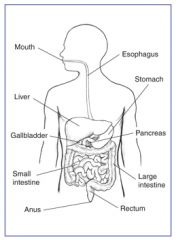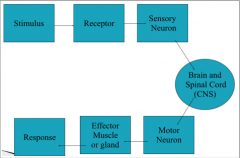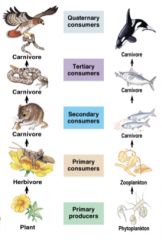![]()
![]()
![]()
Use LEFT and RIGHT arrow keys to navigate between flashcards;
Use UP and DOWN arrow keys to flip the card;
H to show hint;
A reads text to speech;
68 Cards in this Set
- Front
- Back
|
Difference Between Prokaryotic and Eukaryotic Cells |
Eukaryotic cells have a nucleus, and are usually multicellular whereas e.g animal Prokaryotic cells have no nucleus and are usually unicellular. E.g bacteria |
|
|
Difference Between Animal and Plant Cells |
Plant cells have a cell wall, and a chloroplast and are rectangular Animal cells have none of those things and are usually round. |
|
|
Mitochondria |
To perform cellular respiration |
|
|
Endoplasmic Reticulum |
To transport substances around the cell |
|
|
Ribosomes |
To build amino acids from complex proteins
|
|
|
Nucleus |
To co-ordinate all activities within the cell |
|
|
Golgi Apparatus |
To package and store substances into vesicles |
|
|
Vacuole |
To serve as a storage place for water, proteins, nutrients and minerals |
|
|
Cell Membrane |
To maintain the contents of the cell |
|
|
Cell Wall |
To protect the contents of the cell |
|
|
Chloroplast |
To absorb light energy and make it available for photosynthesis |
|
|
Lysome |
To breakdown materials |
|
|
Diffusion |
The net movement of molecules from an area of high concentration to one of low concentration, down a concentration gradient, through a partially permeable membrane, requiring no energy. |
|
|
Facilitated Diffusion |
The net movement of molecules from an area of high concentration to one of low concentration, down a concentration gradient, through a protein channel, requiring no energy. |
|
|
Osmosis |
The movement of water molecules from an area of high water concentration to one of low water concentration, through a semi-permeable membrane with no energy. |
|
|
Active Transport |
The movement of molecules from an area with low concentration to an area with high concentration. Requires energy because it goes against the concentration gradient. |
|
|
Bulk Transport |
Requires Energy Exocytosis - transport of materials out of the cell Endocytosis - transport of materials into the cell |
|
|
Surface Area to Volume Ratio |
Having a large ratio enhances cell exchange. Small and flat shapes have higher ratios. |
|
|
Photosynthesis |
6 CO2 + 6 H2O → C6H12O6 + 6 O2 Carbon dioxide + water → Glucose + Oxygen The conversion of light energy to glucose. |
|
|
Chloroplast |
Where photosynthesis occurs. Contains chlorophyll, a green pigment that traps light. |
|
|
Cellular Respiration |
C6H12O6 + 6 O2 → 6 CO2 + 6 H2O + 36-38 ATP Glucose + Oxygen → Carbon dioxide + water + 36-38 ATP The transfer of glucose into ATP |
|
|
Xylem & Phloem |
- The xylem carries water and mineral up the stem (transpiration). It only goes up. - The phloem carries sugar (translocation). It can go in either direction. |
|
|
Digestive System Diagram |

|
|
|
Function of the mouth |
to chew to break the food into pieces that are more easily digested. |
|
|
Function of the oesophagus |
to deliver food to your stomach using peristalsis. |
|
|
Function of the liver |
to process the nutrients absorbed from the small intestine. |
|
|
Function of the stomach |
to hold food while it is being mixed with enzymes that continue the process of breaking down food into a usable form. |
|
|
Function of the pancreas |
to secrete digestive enzymes into the duodenum (first part of the small intestine). |
|
|
Function of the gallbladder |
to store and concentrate bile and then release it into the duodenum. |
|
|
Function of the large intestine |
it's responsible for processing waste so that emptying the bowels is easy and convenient. |
|
|
Function of the small intestine |
the duodenum is largely responsible for the continuous breaking-down process the jejunum and ileum mainly responsible for absorption of nutrients into the bloodstream. |
|
|
Function of the rectum |
to receive stool from the colon and to hold the stool until evacuation happens. |
|
|
Function of the anus |
to control the expulsion of feces |
|
|
Mechanical vs Chemical digestion |
Mechanical digestion is the physical breaking down of food whereas chemical deals with the absorption of food. |
|
|
Elimination of waste |
Elimination of waste involves the large intestine where waste is processed, the rectum where the faeces is received and held until evacuation happens and the anus where the evacuation takes place. |
|
|
Absorption of nutrients |
Absorption of nutrients involves enzymes and mostly takes place in the small intestine. |
|
|
Herbivore teeth |
Herbivores mostly have molars of herbivores which are wider and flatter, designed to grind food. (Herbivore incisors are sharp for tearing plants, but they may not be present on both the upper and lower jaw.) |
|
|
Carnivore teeth |
They have sharp incisors and pointed canine teeth are perfectly designed for both incapacitating and eating a meal. The molars are fewer in number mainly because so much of the work is done by the teeth in the front of the mouth. |
|
|
Omnivore teeth |
Each omnivore will have teeth that are specifically adapted to the diet these animals consume. Animals with teeth like humans that use their molars for grinding and their incisors and canines for ripping or tearing. |
|
|
Hindgut fermenters |
A hindgut fermenter has a large and long large intestine as most of their digestion is done in there large intestine. Hindgut fermenters are herbivores. An example is a rabbit. |
|
|
Foregut fermenters |
Foregut fermenters have a large 4 chambered stomach as most of their digestion of cellulose and nutrients is done in the stomach. Foregut fermenters are herbivores. An example is a deer. |
|
|
Homeostasis |
Homeostasis is the maintenance of a relatively stable internal environment. |
|
|
Negative Feedback |
Negative feedback is a system of control where if a change is detected in a variable, an action occurs to produce a change in the opposite direction. |
|
|
Nerves |
* The nerve cell or neuron is the functional unit of the nervous system.
* The three main types of neurons are sensory neurons (aka affector, conduct information from receptors to CNS), intermediate neurons (inter connections) and the motor neurons (aka effector, leave CNS and stimulate muscles or glands). |
|
|
Nerves (picture) |

|
|
|
Stimulus response model |

|
|
|
Water balance |
Water balance involves osmoregulation which is the regulation of water. This involves balancing water loss with water gain. In mammals, osmoregulation is controlled by hormones using negative feedback. |
|
|
Glucose regulation |
Glucose regulation is under the control of two hormones insulin and glucagon both of which are produced by the pancreas. Insulin is released when glucose levels are higher than the set range. Glucagon is released when glucose levels are lower than the set range. |
|
|
Thermoregulation |
Thermoregulation is the process that allows the human body to maintain its core internal temperature. |
|
|
Physiological adaptations |
Physiological adaptations are adaptations related to the physiology of the animal. E.g; high rate of metabolism for cold weather and low rate of metabolism for hot weather. |
|
|
Structural adaptations |
Structural adaptations are adaptations related to the structure of the animal. E.g; thick insulation layer for cold weather and large ears for hot weather. |
|
|
Behavioural adaptations |
Behavioural adaptations are adaptations related to the behaviour of the animal. E.g; huddling in cold weather and seeking shelter in hot weather. |
|
|
Dichotomous keys |
Dichotomous keys are tools used to identify organisms. They involve choosing from a series of paired options until an organism is identified. |
|
|
Binomial naming system |
When the last two levels of classification are given; the genus and species name. It was first proposed by Linnaeus (Carl von Linne). |
|
|
Cladistics |
a method of classification of animals and plants that aims to identify and take account of only those shared characteristics. |
|
|
5 kingdoms |
-Animalia -Plantae -Fungi -Protista -Monera |
|
|
Classification hierarchy |
1. Kingdom
2. Phylum 3. Class 4. Order 5. Family 6. Genus 7. Species |
|
|
Communities and populations |
* Each community is made up of populations of various organisms living in the same location at the same time.
* Each population consists of one species * community 1 = population 1 + population 2 + population 3 |
|
|
Autotrophs and Heterotrophs |
* Producers (Autotrophs)
* Consumers (Heterotrophs) which can be subdivided into the following groups: * Herbivores – eat plants * Carnivores – eat other organisms * Omnivores – eat both * Detritivores – eat decomposing organic matter (e.g dead leaves, faeces, rotting algae, dead organisms) * Decomposers - obtain their energy and nutrients from ‘dead’ organic matter. |
|
|
Competition |
Competition occurs when one organism or one species is more efficient than another in gaining access to a limited resource, such as light, water or territory. (e.g fighting monkeys) |
|
|
Predator-prey |
Occurs when one species (the predator) kills and eats another living animal (the prey). (e.g lion and deer) Camouflage: blending in Mimicry: pretending to be something you’re not |
|
|
Parasitism |
One kind of organism (the parasite) lives on or in another kind (the host) and feeds on it, typically without killing it. But the host suffers various negative effects in this relationship and only the parasite benefits. (fungi and corroboree frog) |
|
|
Mutualsim |
Prolonged association of two different species in which both partners gain some benefit. (e.g mistletoe birds and mistletoe plants; fungi and algae that form lichens). |
|
|
Commensalism |
One member gains benefit and the other member neither suffers harm nor gains apparent benefit. (e.g the clown fish that lives among the tentacles of sea anemones for shelter and food scraps). |
|
|
Energy flow |
* All the energy found within ecosystems is provided initially by the sun
* Light energy must be converted into chemical energy to be of any use to nearly all organisms * The only organisms that can accomplish this are; * Plants * Algae * Cyanobacteria |
|
|
Trophic levels |

|
|
|
Food chains |
A food chain is a series of links between different organisms in an ecosystem based on feeding relationships. |
|
|
Keystone species |
A keystone species is an organism that prevents organisms from the lower trophic levels monopolising food and space. |

